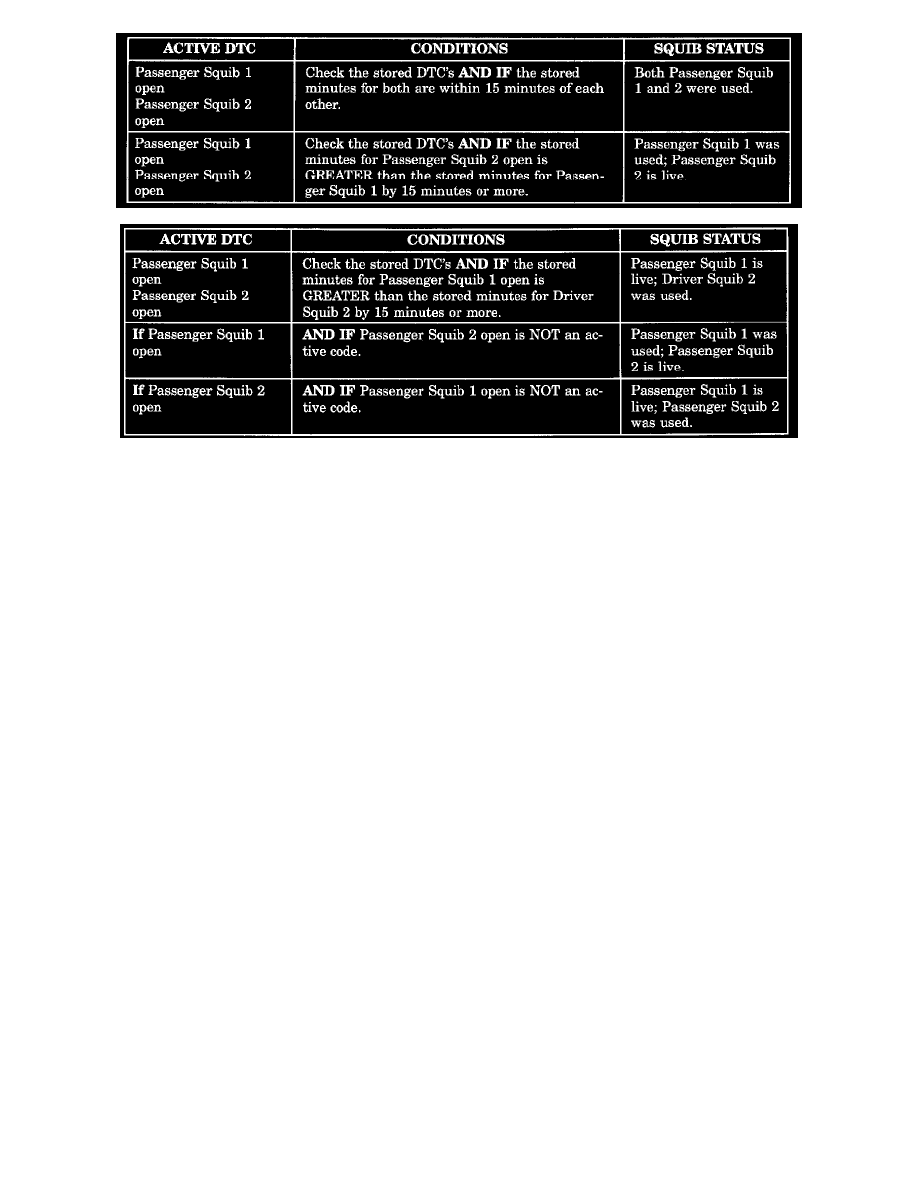Grand Cherokee 4WD V8-4.7L (2003)

1. Using a DRBIII read Airbag DTC's If the following active codes are present:
If neither of the following codes is an active code:
ACTIVE DTC ................................................................................................................................................................................ SQUIB STATUS
Passenger squib 1 open .................................................................................................................................................. Status of Airbag is Unknown
Passenger squib 2 open .................................................................................................................................................. Status of Airbag is Unknown
SEAT BELT SWITCHES (SBS)
The hall-effect driver seat belt switch provide the seat belt status, buckled or unbuckled, via hard- wired inputs to the ACM. The ACM uses seat belt
switch input to determine the appropriate level of airbag deployment. The ACM also controls the seat belt warning indicator via a PCI Bus message to
the instrument cluster. The indicator will be turned on if the driver seat belt status is unbuckled. If the seat belt switch is damaged or defective the seat
belt buckle assembly must be replaced. The ACM continuously monitors the seat belt switch circuits for an open or shorted conditions.
CURTAIN AIRBAGS
The Left and Right curtain airbags are located in the outboard edge of the roof under the headliner, just above the door openings. When supplied with
the proper electrical signal the inflator can discharge the compress gas directly into the curtain airbag. Upon deployment, the curtain will tear open the
headliner allowing the curtain airbag to fully deploy between the headliner and seat. The curtain airbag cannot re repaired and must be replaced if
deployed or in any way damaged.
WARNING: THE CURTAIN AIRBAG CONTAINS AN INERT GAS PRESSURIZED TO 17236.89 kPa (2500 PSI). DO NOT ATTEMPT
TO DISMANTLE AN AIRBAG MODULE OR TAMPER WITH ITS INFLATOR. DO NOT PUNCTURE, INCINERATE, OR BRING
INTO CONTACT WITH ELECTRICITY. DO NOT STORE AT TEMPERATURE EXCEEDING 93 degrees C (200 degrees F). REPLACE
AIRBAG SYSTEM COMPONENTS ONLY WITH PARTS SPECIFIED IN THE CHRYSLER MOPAR PARTS CATALOG. SUBSTITUTE
PARTS MAY APPEAR INTERCHANGEABLE, BUT INTERNAL DIFFERENCES MAY RESULT IN INFERIOR OCCUPANT
PROTECTION. THE FASTENERS, SCREWS, AND BOLTS ORIGINALLY USED FOR THE AIRBAG SYSTEM COMPONENTS HAVE
SPECIAL COATINGS AND ARE SPECIFICALLY DESIGNED FOR THE AIRBAG SYSTEM THEY MUST NEVER BE REPLACED
WITH ANY SUBSTITUTES. ANY TIME A NEW FASTENER IS NEEDED, REPLACE IT WITH THE CORRECT FASTENERS
PROVIDED IN THE SERVICE PACKAGE OR SPECIFIED IN THE MOPAR PARTS CATALOG.
FRONT IMPACT SENSOR
The front impact sensors are electronic accelerometers that sense the rate of vehicle deceleration, and then combined with the ACM Accelerometer
provides verification of the direction and severity of an impact. Each sensor also contains an electronic communication chip that allows the unit to
communicate the sensor status as well as sensor fault information to the microprocessor in the Airbag Control Module. The ACM microprocessor
continuously monitors all of the front passive restraint system electrical circuits to determine the system readiness. If the ACM detects a system fault,
it sets a Diagnostic Trouble Code and controls the airbag indicator operation accordingly. The impact sensors each receive battery current and ground
through dedicated left and right sensor signal and ground circuits from the ACM. The impact sensors and the ACM communicate by modulating the
voltage in the sensor signal circuit. If the sensor is dropped it must be replaced. Disconnect the battery or remove both airbag fuses before servicing
impact sensors.
CAUTION: Do not remove or install impact sensors while the sensor is connected to the vehicle wiring.
